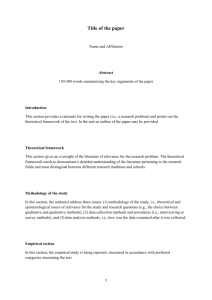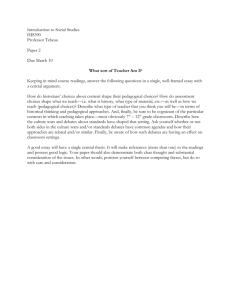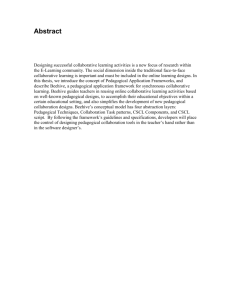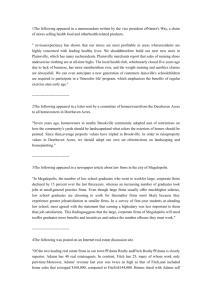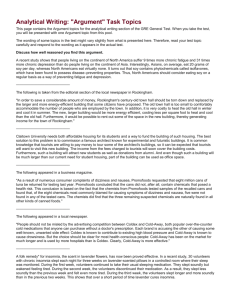A systematic review of literature examining the impact of homework
advertisement
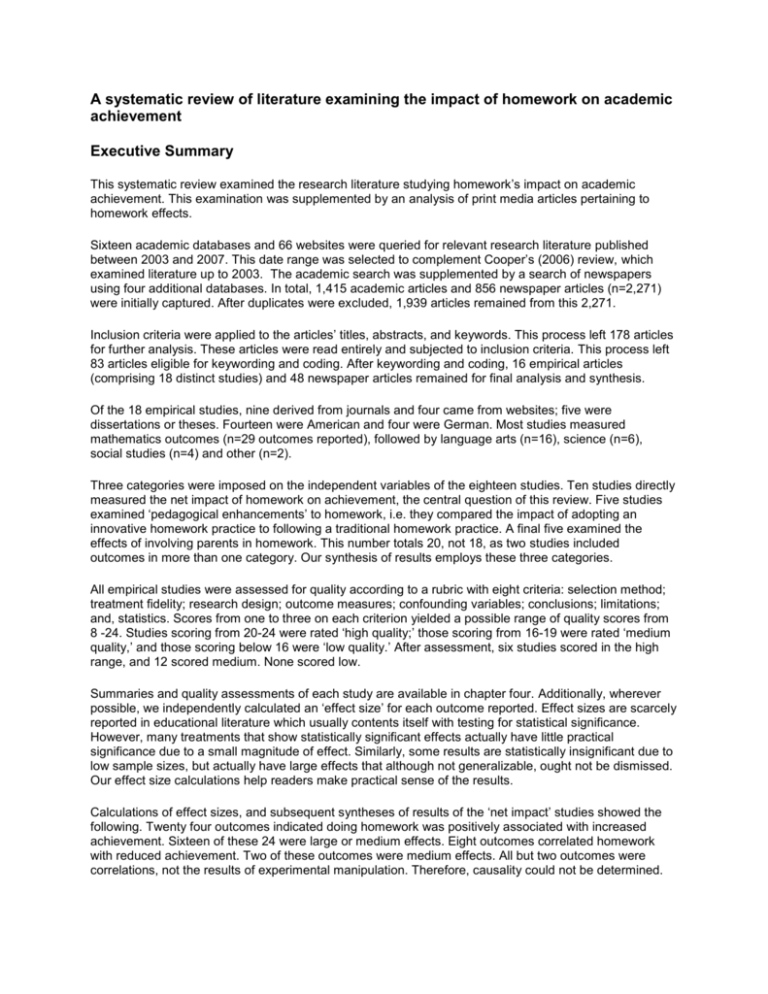
A systematic review of literature examining the impact of homework on academic achievement Executive Summary This systematic review examined the research literature studying homework’s impact on academic achievement. This examination was supplemented by an analysis of print media articles pertaining to homework effects. Sixteen academic databases and 66 websites were queried for relevant research literature published between 2003 and 2007. This date range was selected to complement Cooper’s (2006) review, which examined literature up to 2003. The academic search was supplemented by a search of newspapers using four additional databases. In total, 1,415 academic articles and 856 newspaper articles (n=2,271) were initially captured. After duplicates were excluded, 1,939 articles remained from this 2,271. Inclusion criteria were applied to the articles’ titles, abstracts, and keywords. This process left 178 articles for further analysis. These articles were read entirely and subjected to inclusion criteria. This process left 83 articles eligible for keywording and coding. After keywording and coding, 16 empirical articles (comprising 18 distinct studies) and 48 newspaper articles remained for final analysis and synthesis. Of the 18 empirical studies, nine derived from journals and four came from websites; five were dissertations or theses. Fourteen were American and four were German. Most studies measured mathematics outcomes (n=29 outcomes reported), followed by language arts (n=16), science (n=6), social studies (n=4) and other (n=2). Three categories were imposed on the independent variables of the eighteen studies. Ten studies directly measured the net impact of homework on achievement, the central question of this review. Five studies examined ‘pedagogical enhancements’ to homework, i.e. they compared the impact of adopting an innovative homework practice to following a traditional homework practice. A final five examined the effects of involving parents in homework. This number totals 20, not 18, as two studies included outcomes in more than one category. Our synthesis of results employs these three categories. All empirical studies were assessed for quality according to a rubric with eight criteria: selection method; treatment fidelity; research design; outcome measures; confounding variables; conclusions; limitations; and, statistics. Scores from one to three on each criterion yielded a possible range of quality scores from 8 -24. Studies scoring from 20-24 were rated ‘high quality;’ those scoring from 16-19 were rated ‘medium quality,’ and those scoring below 16 were ‘low quality.’ After assessment, six studies scored in the high range, and 12 scored medium. None scored low. Summaries and quality assessments of each study are available in chapter four. Additionally, wherever possible, we independently calculated an ‘effect size’ for each outcome reported. Effect sizes are scarcely reported in educational literature which usually contents itself with testing for statistical significance. However, many treatments that show statistically significant effects actually have little practical significance due to a small magnitude of effect. Similarly, some results are statistically insignificant due to low sample sizes, but actually have large effects that although not generalizable, ought not be dismissed. Our effect size calculations help readers make practical sense of the results. Calculations of effect sizes, and subsequent syntheses of results of the ‘net impact’ studies showed the following. Twenty four outcomes indicated doing homework was positively associated with increased achievement. Sixteen of these 24 were large or medium effects. Eight outcomes correlated homework with reduced achievement. Two of these outcomes were medium effects. All but two outcomes were correlations, not the results of experimental manipulation. Therefore, causality could not be determined. Some important nuances to the results that generally favoured homework were uncovered. First, homework appeared not to be positively correlated with achievement at the individual level. That is, individuals who did more homework than their classmates were often lower achievers. This is because homework is often a remedial activity. Homework appeared to be an advantage at the class and school level. That is, students enrolled in classes and schools that assigned more homework achieved higher than students who enrolled in classes and schools that assigned less homework. Critically though, it could not be established from this body of research that the positive correlation between homework and achievement did not result from higher achievers attending the types of schools that assign more homework. Where proper statistical modeling (e.g. HLM) could account for class and school effects, much of the advantage to spending more time on homework was lost. Secondly, measures of ‘effort’ on homework rather than ‘time’ or ‘frequency’ appeared to be the best predictors of academic achievement. Sixteen outcomes measured the effects of ‘pedagogical enhancements’ to homework on achievement. Five outcomes had medium sized effects; five had small effects; six had effects incalculable from data reported. All outcomes favoured the experimental treatments, though one was statistically insignificant. When homework assignation or regulation was delivered with an enhanced pedagogical technique, typically one that involved active learning rather than rote repetition, the result appeared to be a small to moderate improvement in student achievement. Nine outcomes measured the effects on achievement of involving parents in homework. Although seven effects were positive, and five of these large, all seven derived from only three studies. It was unclear if parental involvement was actually the mediating factor in one of the studies. By contrast, the two ‘no effect’ results derived from two studies. Had these latter two studies contained more outcome variables, results would likely have appeared more balanced. Our results only indicate no harm appears to result from involving parents with homework. Print media results were also analyzed. Twenty articles depicted homework negatively. Twelve described both positive and negative attributes of homework. Eight were neutral and eight were entirely positive. Overall, the media portrayal of homework was negative. The largest concerns were the excessive quantities of homework, and the burden it placed on families. A gap was therefore found between the research literature and the popular media. While the research attempts to connect homework quantity and quality with achievement, media appears to report on the emotional burden experienced by students and parents. A number of policy implications were developed from these findings. Homework that increases active student engagement with the homework task likely boosts achievement. This was the primary result of the ‘pedagogical enhancement’ studies, as well as the net impact studies, which indicated the importance of ‘effort’ rather than ‘time.’ There is probably an academic benefit to the judicious assignment of homework. Classes and schools that assign more homework appear, to a point, to produce students with better achievement than classes and schools which assign less. Overall though, empirical evidence connecting homework quantity to higher achievement was qualified. This fact, along with the negative perceptions of homework portrayed in the media, suggests teachers and schools be judicious in their homework assignments. Homework will likely produce different results in different student groups. Older students and lower achieving students appear to have the most to gain from homework. Homework’s impact on achievement likely stems from effort more than time. When students focus on their homework – because it is intrinsically motivating or because they have good study habits – achievement increases. There is no harm to involving parents in children’s homework at the earlier stages of their schooling. Future research directions are also suggested. They included research into: Type of homework. What exactly makes homework tasks effective? The role of parents. Firm conclusions regarding best practices with parents are yet to be reached. Age/grade level. None of the studies here examined the net impact of homework vis-à-vis young students. Socio-demographics. Different homework interventions may lead to different results for different demographic groups. The quantity question. It is difficult to estimate homework’s impact from the correlational research available. (Quasi-)experimental research would be welcome. Parent perceptions. Substantive research verifying and uncovering the levels and nuances of parent concerns would help decision makers separate ‘real’ public concern from perceptions filtered through the media. Other academic and non-academic outcomes. The studies here focused heavily on mathematics and, to a lesser degree, reading. Other subject areas, and possible psychological impacts of homework, warrant further study.



